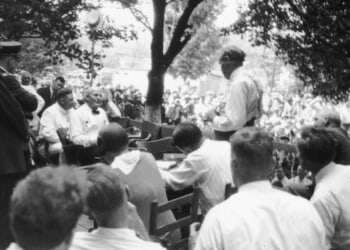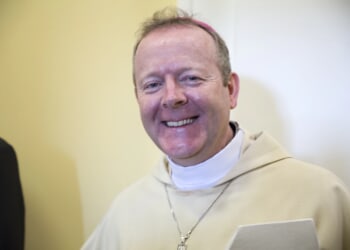As it is appointed unto men once to die, but after this the judgment: So Christ was once offered to bear the sins of many.
— Hebrews 9:27-28
America was largely founded, substantially settled, and essentially established on Christian foundations. The models for colonies’ governments and the blueprints for “framing” documents were Biblical. Even Deists among the Founding Fathers generally acknowledged the Bible as their guide for designing constitutions and the governing documents.
America’s spiritual moorings were derived from more than such influences, however. The nation has often had “parallel leadership” from among Christian figures. Pilgrims came to the New World in search of religious freedom. Among them were Puritans. Before the Revolution — and helping to fuel its liberty-loving fervor — was the Great Awakening. Preachers like Jonathan Edwards, George Whitefield, and the Wesley brothers were enormously influential throughout the colonies and the new United States. In the next generations, the Second Great Awakening, and religious figures like Henry Ward Beecher and his sister Harriet Beecher Stowe persuasively argued against slavery and for social reform. Open-air revival meetings were conducted on Wall Street and other major sites.
… and so through much of American history. No matter the tenor of political changes and social trends, preachers, evangelists, and Gospel songwriters influenced broad swaths of American culture. Camp-meetings as Americans moved Westward, massive urban revivals, and new denominations. Clergy as best-selling authors and influential lecturers have always been prominent in public debates. The D.L. Moodys, Billy Sundays, Aimee Semple McPhersons, and Father Coughlins of yesterday prefigured “America’s Pastor,” Billy Graham.
While one segment of America was discovering Jesus in California in the 1960s and ‘70s — the “Jesus Movement” on the beaches — another revolution was sweeping through more traditional neighborhoods, families, and denominations: Pentecostalism. There were many leaders, including Oral Roberts, Pat Robertson, and Jim Bakker. They sustained ostracism from mainstream denominations, yet they flourished. Many of them built huge empires that eventually were undermined by corruption and scandals, frequently self-inflicted.
The death of Reverend Jimmy Swaggart, who died on July 1, 2025, is a case in point. He became a figure of major influence in American religious life and even politics, endured scandal and self-abasement, and was an actor in a sad but not uncommon scenario… but his last chapters reflected redemption and “overcoming.” His flock remained with him or regrouped. He rebuilt his major Pentecostal movement through fidelity to its basic tenets, but also by shifting the focus and presentation of his message, or God’s message as He received it.
Forty years ago, Jimmy Swaggart was invited to the White House by Ronald Reagan, and last year, a new president, Donald Trump, placed calls to his office. In the 1980s, Swaggart graced the covers of weekly news magazines; recently, he was feted at his 90th birthday celebration by the likes of Bill Gaither and Franklin Graham, the son of Billy Graham, who once disdained his style of preaching and much of its substance. Between the “first and second” Swaggarts, he also overcame near-universal opprobrium after being caught with prostitutes.
Jimmy Swaggart’s struggles, victories, and personal “overcoming” will be a testament living beyond his grave.
By the time of his death, Swaggart was the longest-running televangelist and possibly the most prominent expositor of Protestant Christianity in the world; certainly the leading exponent of Pentecostalism, which is sweeping the globe, especially south of the Equator. His ministry of frequent and massive crusades across America and in numerous overseas countries was supplanted by a media ministry, the only 24/7 Christian cable channel offering exclusive programming of a single ministry. Myriad worship services originate in his large headquarters in Baton Rouge, Louisiana; he published a monthly magazine and produced dozens of CDs and DVDs featuring his own distinctive performances and those of his large and talented worship team. Scores of published books and tracts written by Swaggart are ministry staples.
Over his career, Swaggart inadvertently provided an additional meaning to the Biblical phrase “Born Again.”
+ + +
Jimmy Lee Swaggart was born on the Ides of March, 1935, within months of his cousins Jerry Lee Lewis, a pioneer of rock and roll, and Mickey Gilley, the popular country-music star whose nightclub Gilley’s was the setting of the movie Urban Cowboy. The clan, whose family tree resembles, rather, a twisted vine, counts other piano-playing preachers and recording stars. Linda Gail Lewis (Jerry Lee’s sister), for instance, began her career in the 1960s and still records and performs, with a large following in Europe as a rockabilly queen. That family tree, planted and nurtured around small Ferriday, Louisiana, is replete with intermarriage, multiple marriages (Jerry and Linda Gail each having tied the knot seven times through the years), adultery, and illegitimate siblings and cousins. In that medley, Jimmy and Jerry Lee were double first cousins.
Jimmy Swaggart himself had one marriage, to Frances Anderson of Wisner, Louisiana, and one child, Donnie, who was named after Swaggart’s older brother, who had died in infancy. It is curious to note that Swaggart, Jerry Lee Lewis, Johnny Cash, and Ray Charles all had older brothers who died in accidents when they were boys. The rural South of the 1930s dished up a strange, but common, set of touchstones — tragedy, poverty, violence, music, and religious fundamentalism.
After his hardscrabble family of drinkers, roustabouts, and lawbreakers got saved in a tent revival, young Jimmy felt a calling to be an evangelist. After his marriage at age 17 (Frances was 15), they travelled with Donnie and a lone accordion, singing Gospel songs and preaching — initially to sparse groups, and sleeping in their car or in church basements.
In 1957, his cousin Jerry Lee Lewis, recently signed to a recording contract with Elvis’s label Sun Records, mightily defined rock ‘n’ roll with massive hit songs like Whole Lotta Shakin’ Goin’ On and Great Balls Of Fire, making tens of thousands of dollars a night and appearing on network TV. Jerry Lee and Sam Phillips of Sun Records arranged to launch a Gospel line with Swaggart as its featured performer. But the young evangelist declined the offer, believing that God wanted him to preach, not sing.
Swaggart was destined — called — to do both.
+ + +
In the late 1950s, Swaggart gradually expanded his ministry from small churches and modest tent revivals to larger crusades, recording traditional Southern Gospel songs and attracting radio airtime. The dynamic music was “bait,” he said, to draw people to the preaching; and vice versa in other cases.
Through the 1970s and 1980s, Jimmy Swaggart Ministries grew exponentially. He established a church in Baton Rouge, Family Worship Center; he founded a Bible College; his radio empire expanded to television, buying time on stations to form a de facto network; crusades became major events in major venues in major cities… expanding to mass meetings in many countries around the world, often filling entire stadiums. Many of his singers and musicians, like Janet Paschal and John Starnes, graduated to successful solo careers. By the mid-1980s, his telecast, now a full hour in length, was carried on 250 stations. Swaggart’s template for crusades was a Friday evangelistic message; a Saturday “invitation service” for people to respond to altar calls; and a Sunday service explaining the Gifts of the Spirit for those eager to receive them.
The on-stage evangelist Jimmy Swaggart was electric — a handsome, talented, exuberant musician, singer, and preacher. Inevitably, his anointed messages were accompanied by sweat and tears and “hard” preaching against sin, apostasy, liberal theology, “dead churches,” and such. He had little trouble criticising rival preachers, some by name, and he received criticism back. The Christian Right was ascendant in politics at the time; Pentecostal and Charismatic ministries were naturally compatible with those social and political impulses.
But “Pride goeth before a fall,” and a spate of scandals soiled the Pentecostal movement in the mid-1980s. Jim Bakker had sex with a church secretary and was later sent to jail for financial improprieties at the tacky Christian theme park established by him and his tacky wife Tammy Faye. Jerry Falwell, who had successfully penetrated the political world through his Moral Majority, embarrassed himself in the scramble for Bakker’s empire. Oral Roberts said that God would kill him if supporters fell short of donation goals. (The goal was met, and the Lord did not immediately take Roberts’s life.) Ministers engaged in “Name It and Claim It” promises and invented a seductive “Prosperity Gospel.” Many other ministries were embroiled, seemingly every other month, in sex or financial or doctrinal scandals.
An Elmer Gantry-type, if there ever were one, Swaggart continued his hellfire preaching at the time, severely criticizing many of his fellow evangelists on moral and theological grounds. Many rapacious “reporters” like Geraldo Rivera and CNN’s John Camp devoted themselves to finding chinks in Swaggart’s armor. Beyond defending himself and the Gospel, his attitude and body language in interviews signalled the Pride about which Scripture warns.
Indeed, it foreshadowed a fall — from grace, from a mass following, and from respect and respectability in the Christian world. In 1988, a rival Louisiana preacher with whom Swaggart had tussled caught Jimmy with a prostitute in a cheap motel outside New Orleans. The preacher’s men took photographic evidence and slashed Swaggart’s tires. A nationwide scandal ensued; Swaggart confessed in an apology to God and Frances and Donnie that was picked up by a multitude of TV stations and magazine covers. His tear-stained face and contorted expression were cemented in the public’s mind as the new face of Pentecostalism. Swaggart’s denomination, the Assemblies of God, rebuked him and ordered corrective steps designed to rehabilitate the preacher and rescue his ministry.
Swaggart accepted some discipline, but ignored other recommendations. He self-exiled, but returned to his pulpit sooner than the church ruled. The denomination eventually revoked Swaggart’s ministry credentials. Offerings and donations drastically dropped. Enrollment at the Bible College fell from 1451 to 370. Grass grew in the cracks of Family Worship Center’s parking lots.
+ + +
During these very times, I was working on a project about the Cousins Swaggart, Jerry Lee Lewis, and Mickey Gilley. I had interviewed all three and many of their relatives, associates, and even students at Swaggart’s Bible College. Even a prostitute he was caught with.
His confession aligned with the facts. Whether his apologies — more correctly, signs of repentance — were sincere became a matter of fierce debate.
After the service at which he returned to the pulpit, I approached him and expressed the hope that his failing, and what I assumed would be his repentance and rehabilitation, could make for a powerful message to a public comprised, after all, of sinners and flawed people. And that I would tell that story without tabloid flavors. He replied with what I have since called a Pentecostal No: “Brother Marschall, I’ll pray about it.”
In Jimmy Swaggart’s message that day, the theme centered on the Biblical figure of King David — that he too (I add the “too,” because it was obvious Swaggart drew a comparison to himself) engaged in lust and adultery, and was guilty of much. But none of that, Swaggart noted, changed the fact that God had a call on David’s life. With that anointing, David eventually carried out amazing tasks that God had set before him.
It was a facile argument, given the circumstances in Baton Rouge that morning, and yet it was theologically sound.
The road that Jimmy Swaggart walked thereafter, whether out of desperation or by design — his or God’s — has been unique. Perhaps it was a strategic withdrawal from the ministry’s program. The overseas crusades largely ended, as did many stateside crusades. The face-to-the-world aspect of his ministry became the home church, Family Worship Center, featuring three services a week and various camp meetings and special conferences. An extensive media ministry was established through his new outlet, SonLife Broadcasting. A core group of staffers, musicians, singers, and teachers loyally remained. A children’s ministry was expanded.
The ministry outreach grew, particularly in exegetical material (Swaggart’s Bible studies total more than 7,500 pages). He claimed a divine revelation that directed him to address “the message of the Cross,” asserting that aspect of Jesus’s sacrifice as the proper focus of Christians’ faith. In the course of his latter-day ministry activities, I have joined those who believe his ultimate repentance was sincere.
Swaggart was joined in the pulpit by his son Donnie and grandson Gabriel Swaggart. In the years before his death, they assumed virtually all the ministry duties, excellently, breaking a pattern of many televangelists’ kids being weak shadows of their fathers, with the exception of Franklin Graham.
+ + +
In Jimmy Swaggart’s last decades, his fervent delivery mellowed, but not his message. Hellfire themes continued. He never softened his Pentecostal distinctives (his son and grandson emphasize the Gifts even more than he did), and his publications and sermons continued to attack false doctrines and flawed theology in some denominations.
If parts of the general public did not know, or forgot, who Jimmy Swaggart was, it was due to his decision to “feed the sheep” and focus on his congregation, on SonLife’s media outreach, and sharing his theological brand. Appeals for, say, hospitals in India were supplanted by campaigns to provide thousands of Expositor’s Study Bibles to countries around the world. These were important goals of Swaggart until the end, and along the way, he acquired new friends (as calls from Donald Trump, Bill Gaither, Mike Lindell, and a wide variety of others attest) and in new fields of activity. Gabe and especially Donnie became increasingly active and vocal in conservative politics.
… which brings to the fore, full-circle perhaps, the traditional and essential place of Christianity in American life. Jimmy Swaggart’s ultimate re-emergence and influence, and a new (or renewed) America where Donnie Swaggart is invited to White House prayer meetings, and Gabe Swaggart is honored at the Louisiana State Senate, testifies to an important aspect of faith — ultimately, “overcoming” in this corrupt world. The perseverance that lifted the piano-playing preacher from Ferriday, Louisiana, was largely spiritual but also spoke of definition and redefinition; of dispensing and seeking forgiveness; of knowing God and making Him known. Somehow, an American story, too.
Jimmy Swaggart’s struggles, victories, and personal “overcoming” will be a testament living beyond his grave.
He breathed his last earthly breath, as country folks say, about 8:30 a.m. on July 1, 2025. Donnie made the announcement on various ministry platforms, and quoted a verse from II Timothy that his father cited as he was slipping away in recent months: I have fought a good fight, I have finished my course.
+ + +
READ MORE from Rick Marschall:
James A. Garfield: The Man Who ‘Stepped Down’ to Become President
Carter: A Man of Little Consequence, Spoils His Farewell
All Hail the Once and Future President, Donald Trump
Rick Marschall still works on his biography of Jimmy Swaggart and Jerry Lee Lewis. He is the author of 75 books and many magazine articles. A commentator and former political cartoonist, he has produced the weekly Christian / music blog, MondayMinistry.com/blog, for more than 15 years. He and his wife, Mickey, live in Holly, MI.









![Florida Man With Violent History Arrested for Choking a Cop [WATCH]](https://www.right2024.com/wp-content/uploads/2025/06/Eleven-Stabbed-in-Attack-at-Salem-Homeless-Shelter-Across-From-350x250.jpg)







